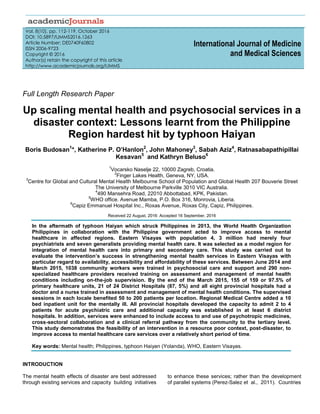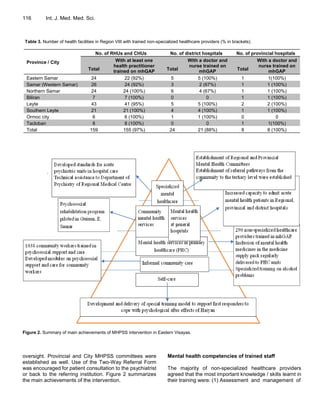The study evaluated the success of an intervention in Eastern Visayas, Philippines to strengthen mental health services following Typhoon Haiyan. [1] Between 2014-2015, 1038 community workers were trained in psychosocial support and 290 healthcare providers received mental health training and supervision. [2] By March 2015, 97.5% of primary care units and 87.5% of district hospitals had trained providers, benefiting 50-200 patients each. [3] Regional hospitals added psychiatric beds and provincial hospitals established acute care capacity, improving availability across all levels of care.



![Budosan et al. 115
Figure 1. Map of Eastern Visayas and its provinces.
Acquired confidence to manage mental conditions. All aspects of
training were evaluated as very good, moderate or in need of
improvement. Observation and evaluation occurred during
supervision visits to government health facilities which were
conducted by WHO’s and IMC’s MHPSS team in their AORs.
Evaluated categories included: (1) History taking of presenting
problem; (2) Thoroughness of mental status examination; (3)
Demonstration of communication skills/empathy; (4) Knowledge of
pharmacologic treatment options; (5) Knowledge of applicable
psychosocial interventions; (6) Education of patient on diagnosis,
treatment, side effects; and (7) Documentation of patient encounter.
All results from all AORs were analysed by the WHO office in
Manila and summarized in the final report (World Health
Organization - Department of Emergency Risk Management and
Humanitarian Response, 2015).
Ethical considerations
A close cooperation with the Philippine government and its
Department of Health (DOH) occurred to ensure approval of
MHPSS activities and their alignment with the national objectives
for mental health. Informed consent was sought from patients
during on-the-job supervision after the purpose of the intervention
was explained. Confidentiality of the information was ensured by
absence of patient identifying data on the study documents. There
was no monetary compensation for this study.
RESULTS
Availability, accessibility and affordability of mental
health services
In one year, the intervention increased the likelihood that
1038 trained personnel would properly provide community
based MHPSS services. Those trained were 609
community health workers, 126 teachers and school
guidance counsellors, 87 social workers, 127 first
responders (firefighters and police personnel) and 89
others (local government unit, NGO, community first
responders). The intervention increased the likelihood
that 290 non- specialized healthcare providers, [130
medical doctors (MD) and 160 public health nurses
(PHN)] would properly manage MH problems in general
healthcare. At project end, 155 of 159 or 97.5% primary
healthcare units [rural health units (RHUs) and city health
units (CHUs)] in Region VIII had at least one healthcare
provider (doctor or nurse) trained in mhGAP. Of 24
District Hospitals (DH), 21 or 87.5% had a doctor and a
nurse trained in mhGAP. All eight provincial hospitals
had at least one doctor and one nurse who could provide
early assessment, treatment and management of common
mental health problems (Table 3). Consequently, mental
health care became more available and more accessible
for the population of Eastern Visayas. Mental health
medicines were included in the medicine supply packs
that the NCPAM regularly delivered to the RHUs and
CHUs. Thus, mental health medicines were also made
more affordable for the general population in Region VIII.
The Regional Mental Health Committee composed of
representatives from: DOH, Department of Education,
Department of Social Welfare and Development (DSWD),
Philippine National Police (PNP), local government units
(LGUs), PhilHealth and NGOs; was established for](https://image.slidesharecdn.com/032ef62b-27fa-4be7-adf4-5e7e9d26b574-170115151924/85/Philippine-paper-published-4-320.jpg)



